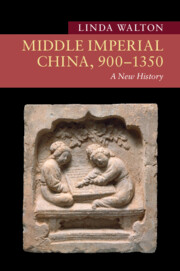Book contents
- Middle Imperial China, 900–1350
- New Approaches to Asian History
- Middle Imperial China, 900–1350
- Copyright page
- Dedication
- Contents
- Figures
- Maps
- Acknowledgments
- Introduction
- 1 The Turbulent Tenth Century
- 2 Song in a Multipolar World
- 3 Schooling, State, and Society in Song and Jin
- 4 An Economic Revolution?
- 5 Cities and Urban Life
- 6 Religious Transformations
- 7 Ways of Knowing
- 8 The Arts of Culture
- 9 Gendered and Generational Lives
- 10 Mapping the Built and Natural Environment
- 11 Sustaining Life and Healing Bodies
- 12 The Mongol Yuan Dynasty in China
- 13 Yuan China in the Mongol Eurasian Empire
- Bibliography
- Index
- New Approaches to Asian History
6 - Religious Transformations
Published online by Cambridge University Press: 20 July 2023
- Middle Imperial China, 900–1350
- New Approaches to Asian History
- Middle Imperial China, 900–1350
- Copyright page
- Dedication
- Contents
- Figures
- Maps
- Acknowledgments
- Introduction
- 1 The Turbulent Tenth Century
- 2 Song in a Multipolar World
- 3 Schooling, State, and Society in Song and Jin
- 4 An Economic Revolution?
- 5 Cities and Urban Life
- 6 Religious Transformations
- 7 Ways of Knowing
- 8 The Arts of Culture
- 9 Gendered and Generational Lives
- 10 Mapping the Built and Natural Environment
- 11 Sustaining Life and Healing Bodies
- 12 The Mongol Yuan Dynasty in China
- 13 Yuan China in the Mongol Eurasian Empire
- Bibliography
- Index
- New Approaches to Asian History
Summary
Religion between the tenth and thirteenth centuries is a rich fabric of Buddhist and Daoist institutional warp threads interwoven with the weft of manifold local deities and religious practices. This period witnessed dramatic sectarian developments in institutionalized Buddhism and Daoism as well as an explosion of popular beliefs and practices.Official scrutiny of such religious activities at times led to suppression of what the state labeled “profane cults.” But there were few, if any, impermeable barriers between so-called “elite” and “popular” religions: clerical religions intersected with localized beliefs, and both personal and professional relationships between clergy and the scholar-official elite were commonplace. The economic and social transformations of the Song created new needs and relationships between spirits and supplicants, leading to what one scholar has called the “vernacularization” of religious practice. Buddhism intersected with empire, especially among the Khitan Liao and Tangut Xi Xia, the rulers of which promoted and patronized Buddhism. As new sectarian developments in Buddhism drew masses to congregational, faith-based practices, Chan monastic institutions also flourished. Daoism acquired influence at the Song court through patronage by more than one emperor, and experienced a renaissance through ritual reform and the transmission and canonization of religious texts.
Keywords
- Type
- Chapter
- Information
- Middle Imperial China, 900–1350A New History, pp. 143 - 166Publisher: Cambridge University PressPrint publication year: 2023



